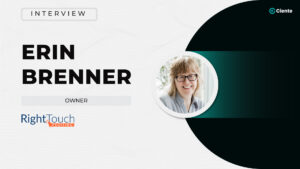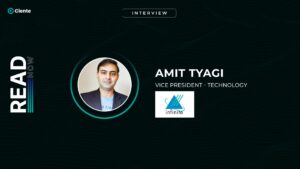Could you share a bit about yourself and your career before Semarchy?
I am responsible for Go-to-Market operations, including marketing, business development, and alliances and partnerships.
Before joining Semarchy, I was the CMO at Logi Analytics, which was acquired by Insight Software. Logi Analytics had a unique business model OEMing embedded data applications with software providers. With a relatively small target customer base marketing efforts required pinpoint accuracy with targeted messaging.
Prior to working with smaller software companies, I spent eleven years at Dell as an executive leading software product and GTM in Dell Client Group. During my time at Dell I helped to lead the evolution from a hardware-centric approach to providing customers with solutions including hardware, software, and services. We reshaped the client industry by emphasizing security and management to address cynical business requirements.
I started my career with IBM and their eBusiness organization. Over nearly a dozen years had the opportunity to work in strategy, marketing, and channel development IBM provided excellent development opportunities working with different software brands, corporate and software headquarter functions.
https://www.linkedin.com/in/brett-h-a130891/
Can you tell us more about the Semarchy and your role there?
Semarchy is a leader in the data integration and master data management markets. It enables organizations to rapidly generate business value from their data. I joined Semarchy due to its unique approach to mastering data. Historically master data management has been a top-down approach driven by restrictive, inflexible templates. Semarchy’s approach is bottom-up providing data professionals the opportunity to rapidly deliver a data product designed specifically for their unique use case and business requirements. This approach allows organizations to deploy quickly, averaging a fully functional MDM solution in under 12 weeks. And as business requirements are always evolving Semarchy seamlessly adapts to updating requirements.
Additionally, Semarchy emphasizes business outcomes with our customers. We provide a dedicated team of MDM experts to work with customers to ensure a successful onboarding experience. We have published Rapid Deliver Blueprints that provide detailed step-by-step instructions from our vast experience. The success of our approach, technology, and people is evidenced in Semarchy’s top ranking in Gartner Peer Index.
Semarchy unique approach
My responsibility at Semarchy is to deliver growth by optimizing pipeline creation and progression. The organization looks to educate, enable, and progress prospects through a positive buyer’s journey across all routes ultimately empowering them to achieve their data objectives. .
What’s your favorite part about working in this industry?
My favorite part about working in this industry is really having the opportunity to drive transformational efforts. Through our efforts at Semarchy we can see really meaningful results for our customers. For instance, our customer Brown-Forman, a leading manufacturing company of brands such as Jack Daniel’s, Old Forester, Woodford Reserve, Diplimatico Rum had extensive third-party data where every data source had different definitions for thousands of products in different locations all over the world. (The organization had over 4,000 master records in the Jack Daniels cluster alone!) The data included Brown-Forman products, but also competitive ones as well. This led to siloed, incomplete, and inaccurate data. Semarchy was able to bring together vast amounts of data into a single source of truth for better insights and competitive knowledge.
Could you introduce us to your platform? What are its distinguishing characteristics?
Semarchy has always led the industry in innovation, particularly with our XDM Master Data Management Software. With a unified platform, robust data quality management, comprehensive data governance, streamlined data integration, advanced analytics, and scalability, Semarchy MDM equips organizations with the tools they need to drive innovation and achieve their business objectives.
The Semarchy Unified Data Platform includes our best-in-class Master Data Management software, xDM, and our data integration software, xDI, allowing companies to unlock the true value of their data. Our xDM Master Data Management solution rapidly delivers value from data assets, and optimizes data stewardship operations. Companies can easily generate data-rich apps with zero code while automating the creation of high-quality golden records for their specific business needs.
Which industry domains does Semarchy mostly cater to?
We like to think of ourselves as a Swiss army knife for all different verticals, but key verticals include the financial, manufacturing, retail and hospitality industries.
How, according to you, can companies keep their data clean in 2023?
The first step is having a data strategy. It can’t all be about the technology, companies need to understand how they want to use their data and how it will apply to their business objectives. It is essential that your solution is able to adapt to your specific business requirements. Those business requirements are going to change, so your solution needs to also be able to change without breaking in order to support the changing business requirements.
Where do you envision marketing’s future in your industry?
The data market has a large and diverse set of competitors including legacy IT vendors (i.e. IBM, Oracle), legacy data vendors (i.e. Tibco, Informatica) and a multitude of data cloud providers. The result is that organizations researching data solutions face a deluge of perspectives – many of which may be contradictory.
Effective marketing in the data industry needs to appreciate this challenge that organizations face to get the right information. Prospects are looking for thoughtful information aligned to where they are within the buying process vs simple vendor hype. This is especially important given that the bulk of the buying process occurs prior to a direct sales engagement.
Our approach is to empower prospects with information that will enable them to make the best decisions for their customers. This includes information on the market and solution best practices early in the process to direct them to the right solution. In the next stages providing prospects with deeper insights, sourcing heavily from customers, analysts and other experts, on the solution itself. Finally, as they transition into a sales engagement arming them with more detailed technical information and tools for TCO and/ or ROI development. While many prospects follow this natural progression our objective is to allow them to follow their own path. Ensuring relevant, educational information is readily available to help them on their journey.
Critical to this success is focusing on the outcome of the prospect, not our own success. Educated and informed customers are the most likely to be the right customers for sales engagement.
What advice would you give to businesses trying to get more value out of their data?
To be successful, it is imperative to work closely with business leaders around their challenges and be able to more effectively engage your existing customers. What are the challenges facing your chief marketing officer? What are the challenges facing your supply chain leader in improving efficiency in inventory management? Then you can apply data to those challenges. You need to sort out a way to get into the business. It’s what the business needs and then you ask what data do I have available to become more efficient and solve those problems.
The number one reason that data projects fail is not technology, but culture and people, so it’s critical to engage with your business leaders at the beginning. Then it’s not about using predefined templates or a top-down approach. You’re going to want to have a solution that fits that business’s specific challenge. You need to take a bottom-up approach where you’re creating a data product specific to your business. It will likely be more successful because it’s your needs and will be more likely to overcome cultural impediments.
According to you, which marketing technologies or tools can significantly empower marketers?
I kind of hit upon this in the last question. I think it’s absolutely essential for the technology to be catered to the requirements of the business. It needs to be a flexible solution. Business requirements are going to change. You’re going to have to continue to evolve and your data product is going to need to be able to be adaptable without having to break it open and start all over again.
Can you give us a sneak peek into Semarchy’s development plans?
We take a very pragmatic approach to all of our development but especially because there’s a lot of excitement around AI right now, it needs to be applied thoughtfully and carefully. In the world of master data management, one of the most exciting possibilities around AI is match and merge. When you’re bringing all this data together, you’re going to have to look at matching different data sources. When you are bringing it all together you want it to match.
I can look at Jennifer Smith in Georgia and Jennifer Smith in South Carolina and Jennifer Smith in California, and understand that those are three different people. That is the work of Data Stewards. It tends to be a lot of very intensive effort. AI could very well replace this work, which is fantastic. However, if it’s a black box that you don’t have insights and control over, it can also be incredibly disruptive in the fact that it’s making a bunch of errors and you don’t know that. The AI bot might assume that all the Jennifer Smiths are the same person. That could be really bad for a bank. You’ve just now matched and merged two people’s financials.
We are embracing AI. We have an open API that allows you to connect. You can fully utilize AI today. We are building new capabilities to help with match/merge and are fully transparent so you are not blindly trusting us to execute really critical parts of your data. The other thing that’s important with AI, just like everything else, is that every business situation is unique. Assuming that a generic AI engine will be able to support your business requirements is highly risky.
Which podcast or book has recently influenced you?
Empires of the Sky: Zeppelins, Airplanes, and Two Men’s Epic Duel to Rule the World by Alexander Rose. It’s a fascinating book about Zeppelins, the Hindenburg, and Pan Am. If you were looking at the world at the turn of the century and you were to say we would be flying in airplanes, we would never have believed it. Zeppelins at the turn of the century were safer, and faster, and provided more luxurious travel. Really for the first couple of decades, everything looked like the Zeppelin was going to be the mode of future transportation. But as we all know, with airplanes there’s been a few dramatic improvements in technology. They jumped ahead and now I’ve flown all over the world in airplanes, but I can’t say I’ve ever flown on a Zeppelin. It was a fascinating look at how it’s easy to presume that one industry is gonna be more successful than another, but how technology and the opportunity for disruption can be profound!

Brett Hansen, Chief Growth Officer, Semarchy
Brett Hansen is Chief Growth Officer at Semarchy, responsible for leading go-to-market strategy for the rapidly growing data company. Prior to joining Semarchy, Brett was CMO at Logi Analytics through its acquisition and integration. He also held marketing and product executive positions at Dell Technologies and IBM. He holds a Bachelor of Science in Economics and History from James Madison University as well as an MBA in Marketing from the University of Montana.






